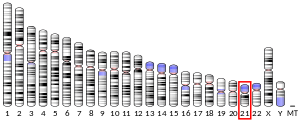MX2
For the aircraft and other subjects see MX2 (disambiguation)
Interferon-induced GTP-binding protein Mx2 is a protein that in humans is encoded by the MX2 gene.[3][4][5]
The protein encoded by this gene has a nuclear and a cytoplasmic form and is a member of both the dynamin family and the family of large GTPases. The nuclear form is localized in a granular pattern in the heterochromatin region beneath the nuclear envelope. A nuclear localization signal (NLS) is present at the amino terminal end of the nuclear form but is lacking in the cytoplasmic form due to use of an alternate translation start codon. This protein is upregulated by interferon-alpha but does not contain the antiviral activity of a similar myxovirus resistance protein 1.[5]
References
- 1 2 3 GRCh38: Ensembl release 89: ENSG00000183486 - Ensembl, May 2017
- ↑ "Human PubMed Reference:".
- ↑ Aebi M, Fah J, Hurt N, Samuel CE, Thomis D, Bazzigher L, Pavlovic J, Haller O, Staeheli P (Feb 1990). "cDNA structures and regulation of two interferon-induced human Mx proteins". Mol Cell Biol. 9 (11): 5062–72. PMC 363658. PMID 2481229.
- ↑ Melen K, Keskinen P, Ronni T, Sareneva T, Lounatmaa K, Julkunen I (Nov 1996). "Human MxB protein, an interferon-alpha-inducible GTPase, contains a nuclear targeting signal and is localized in the heterochromatin region beneath the nuclear envelope". J Biol Chem. 271 (38): 23478–86. doi:10.1074/jbc.271.38.23478. PMID 8798556.
- 1 2 "Entrez Gene: MX2 myxovirus (influenza virus) resistance 2 (mouse)".
Further reading
- Horisberger MA, McMaster GK, Zeller H, et al. (1990). "Cloning and sequence analyses of cDNAs for interferon- and virus-induced human Mx proteins reveal that they contain putative guanine nucleotide-binding sites: functional study of the corresponding gene promoter". J. Virol. 64 (3): 1171–81. PMC 249231. PMID 2154602.
- Horisberger MA, Wathelet M, Szpirer J, et al. (1988). "cDNA cloning and assignment to chromosome 21 of IFI-78K gene, the human equivalent of murine Mx gene". Somat. Cell Mol. Genet. 14 (2): 123–31. doi:10.1007/BF01534397. PMID 3162334.
- al-Masri AN, Werfel T, Jakschies D, von Wussow P (1997). "Intracellular staining of Mx proteins in cells from peripheral blood, bone marrow and skin". Mol. Pathol. 50 (1): 9–14. doi:10.1136/mp.50.1.9. PMC 379572. PMID 9208807.
- Melén K, Julkunen I (1998). "Nuclear cotransport mechanism of cytoplasmic human MxB protein". J. Biol. Chem. 272 (51): 32353–9. doi:10.1074/jbc.272.51.32353. PMID 9405443.
- Hattori M, Fujiyama A, Taylor TD, et al. (2000). "The DNA sequence of human chromosome 21". Nature. 405 (6784): 311–9. doi:10.1038/35012518. PMID 10830953.
- Strausberg RL, Feingold EA, Grouse LH, et al. (2003). "Generation and initial analysis of more than 15,000 full-length human and mouse cDNA sequences". Proc. Natl. Acad. Sci. U.S.A. 99 (26): 16899–903. doi:10.1073/pnas.242603899. PMC 139241. PMID 12477932.
- Ota T, Suzuki Y, Nishikawa T, et al. (2004). "Complete sequencing and characterization of 21,243 full-length human cDNAs". Nat. Genet. 36 (1): 40–5. doi:10.1038/ng1285. PMID 14702039.
- Gerhard DS, Wagner L, Feingold EA, et al. (2004). "The Status, Quality, and Expansion of the NIH Full-Length cDNA Project: The Mammalian Gene Collection (MGC)". Genome Res. 14 (10B): 2121–7. doi:10.1101/gr.2596504. PMC 528928. PMID 15489334.
- Rual JF, Venkatesan K, Hao T, et al. (2005). "Towards a proteome-scale map of the human protein-protein interaction network". Nature. 437 (7062): 1173–8. doi:10.1038/nature04209. PMID 16189514.
- Tanaka S, Honda Y, Honda M (2007). "Identification of Differentially Expressed Genes in Blood Cells of Narcolepsy Patients". Sleep. 30 (8): 974–9. PMC 1978392. PMID 17702266.


